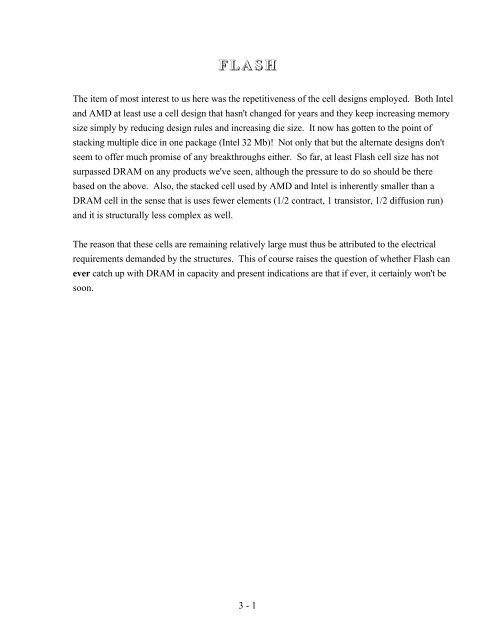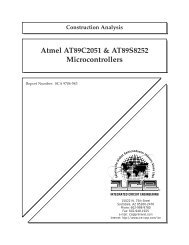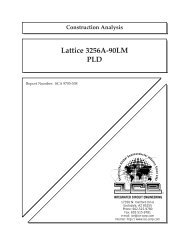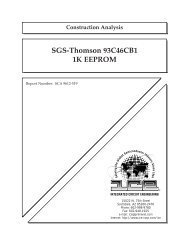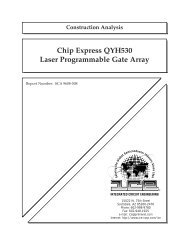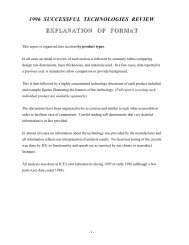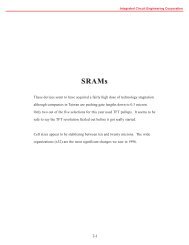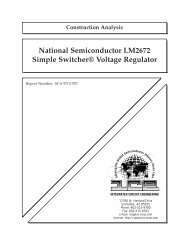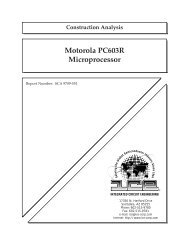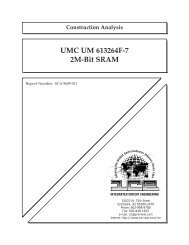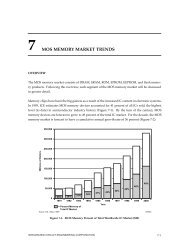Flash - Smithsonian - The Chip Collection
Flash - Smithsonian - The Chip Collection
Flash - Smithsonian - The Chip Collection
Create successful ePaper yourself
Turn your PDF publications into a flip-book with our unique Google optimized e-Paper software.
FLASH<br />
<strong>The</strong> item of most interest to us here was the repetitiveness of the cell designs employed. Both Intel<br />
and AMD at least use a cell design that hasn't changed for years and they keep increasing memory<br />
size simply by reducing design rules and increasing die size. It now has gotten to the point of<br />
stacking multiple dice in one package (Intel 32 Mb)! Not only that but the alternate designs don't<br />
seem to offer much promise of any breakthroughs either. So far, at least <strong>Flash</strong> cell size has not<br />
surpassed DRAM on any products we've seen, although the pressure to do so should be there<br />
based on the above. Also, the stacked cell used by AMD and Intel is inherently smaller than a<br />
DRAM cell in the sense that is uses fewer elements (1/2 contract, 1 transistor, 1/2 diffusion run)<br />
and it is structurally less complex as well.<br />
<strong>The</strong> reason that these cells are remaining relatively large must thus be attributed to the electrical<br />
requirements demanded by the structures. This of course raises the question of whether <strong>Flash</strong> can<br />
ever catch up with DRAM in capacity and present indications are that if ever, it certainly won't be<br />
soon.<br />
3 - 1
FLASH<br />
MEMORIES<br />
HORIZONTAL DIMENSIONS (DESIGN RULES)<br />
INTEL<br />
E28F016SA<br />
16/32Mb 1994<br />
Die size 10.6 x 11.6 mm<br />
(124 mm 2 )<br />
AMD<br />
AM29F016-120EC<br />
16Mb 9436<br />
9 x 9.7 mm<br />
(87 mm 2 )<br />
AMD<br />
AMD29F040-90EC<br />
4Mb 9406<br />
6.6 x 7.5 mm<br />
(50 mm 2 )<br />
*Polycide †Physical gate length measured TABLE 3 - 1<br />
ATMEL<br />
AT29C040-12TC<br />
4Mb 9411<br />
7.8 x 13.7 mm<br />
(107 mm 2 )<br />
Min M2 width 0.8μm 0.75μm 1.3μm 3.4μm NA<br />
Min M1 width 1.0μm 0.9μm 1.0μm 2.2μm 2.0μm<br />
Min M2 space 0.9μm 1.0μm 1.2μm 1.8μm NA<br />
Min M1 space 0.6μm 0.8μm 1.0μm 1.8μm 1.0μm<br />
Min via (M2 to M1) 0.85μm 0.9μm 0.8μm 1.7μm NA<br />
Min cntct (to Si) 0.7μm 0.6μm 0.65μm 1.2μm 1.2μm<br />
SST<br />
NH29EE010-150<br />
1Mb 9417<br />
4.7 x 6.1 mm<br />
(29 mm 2 )<br />
Min Poly 2 0.7μm * 0.55μm * 0.75μm * 0.7μm 0.95μm<br />
Min Poly 1 0.8μm 0.55μm 0.7μm 2.6μm 1.2μm<br />
Min gate - (N)† 0.8μm 0.6μm 0.7μm 0.8μm 0.95μm<br />
Min gate - (P)† 0.7μm 0.65μm 0.85μm 1.5μm 1.2μm<br />
Cell pitch 1.65 x 2μm 1.65 x 1.65μm 2.4 x 2.5μm 2.6 x 6.4μm 3 x 3.5μm<br />
Cell area 3.3μm 2 2.7μm 2 6.0μm 2 16.6μm 2 10.5μm 2
FLASH<br />
MEMORIES<br />
* Polycide TABLE 3 - 2<br />
VERTICAL DIMENSIONS<br />
INTEL<br />
E28F016SA<br />
16/32Mb 1994<br />
AMD<br />
AM29F016-120EC<br />
16Mb 9436<br />
AMD<br />
AMD29F040-90EC<br />
4Mb 9406<br />
ATMEL<br />
AT29C040-12TC<br />
4Mb 9411<br />
SST<br />
NH29EE010-150<br />
1Mb 9417<br />
Final passivation 3.4μm 1.2μm 1.5μm 1.1μm 1.0μm<br />
Metal 2 1.1μm 0.75μm 1.0μm 1.0μm NA<br />
Metal 1 0.5μm 0.7μm 0.5μm 0.85μm 1.3μm<br />
Intermetal dielectric 0.55μm 0.45μm 0.4μm 0.45μm NA<br />
Poly 2 0.3μm * 0.4μm * 0.4μm * 0.45μm 0.3μm<br />
Poly 1 0.1μm 0.1μm 0.15μm 0.2μm 0.05μm<br />
Recessed oxide 0.55μm 0.3μm 0.4μm 0.8μm 0.7μm<br />
N-well 2μm 5μm 5μm 4.5μm 5.5μm<br />
P-well 1.0μm (?) 2μm (?) 3μm (?) 2.5μm None<br />
Epi 6.5μm (P) None None None None
FLASH<br />
MEMORIES<br />
INTEL<br />
E28F016SA<br />
16/32Mb 1994<br />
DIE MATERIALS<br />
AMD<br />
AM29F016-120EC<br />
16Mb 9436<br />
Final passivation Glass on nitride Nitride on SOG<br />
on glass<br />
Metal 2 Titanium-nitride<br />
Aluminum<br />
Titanium<br />
Aluminum<br />
Titanium-nitride<br />
Titanium<br />
TABLE 3 - 3<br />
AMD<br />
AMD29F040-90EC<br />
4Mb 9406<br />
Nitride on SOG<br />
on glass<br />
Aluminum<br />
Titanium<br />
ATMEL<br />
AT29C040-12TC<br />
4Mb 9411<br />
SST<br />
NH29EE010-150<br />
1Mb 9417<br />
Nitride on glass Nitride on glass<br />
Aluminum NA<br />
Contact Plugs Tungsten Tungsten Tungsten NA<br />
Metal 1 Titanium-nitride<br />
Aluminum<br />
Titanium-nitride<br />
Titanium<br />
Aluminum<br />
Titanium-nitride<br />
Titanium<br />
Aluminum<br />
Titanium-nitride<br />
Titanium<br />
Titanium-nitride<br />
Titanium<br />
Aluminum<br />
Titanium-nitride<br />
Titanium<br />
Interpoly dielectric ONO ONO ONO Oxide Oxide<br />
Reflow glass BPSG BPSG BPSG BPSG BPSG<br />
Polycide metal Tungsten Tungsten Tungsten NA NA<br />
Titanium-nitride<br />
Aluminum<br />
Titanium-nitride<br />
Titanium
TECHNOLOGY DESCRIPTION<br />
INTEL E28F016SA/DD28F032SA<br />
16 AND 32 Mbit FLASH MEMORY<br />
Introduction Ref. report SUB 9404-02<br />
<strong>The</strong>se parts (both 16 Mb and 32 Mb) were packaged in 56-pin, gull-wing lead, thin small-outline<br />
packages (TSOPs). As usual, ICE could not decipher Intel's date code, but we believe parts were<br />
manufactured first (16 M) and third (32 M) quarter of 1994. <strong>The</strong> 16 Mb devices were fully<br />
functional production parts, but the 32 Mb units were engineering samples (ES). <strong>The</strong> reason both<br />
part types are included in this analysis is that the 32 Mb part is essentially a packaging method for<br />
two 16 Mb dice. Die technology is the same. <strong>The</strong> parts operate from a 3.3V or 5V supply<br />
voltage.<br />
See tables for specific dimensions and materials identification and see figures for examples of<br />
physical structures.<br />
Unusual/Unique Features<br />
Quality<br />
- Complex process.<br />
- Deep, short birdsbeak, recessed-oxide isolation.<br />
- New assembly (32 Mb).<br />
Quality of process implementation was normal. Metal 2 step coverage at vias showed significant<br />
thinning. Also, the polycide word lines showed loss of the metal silicide at every step over poly 1.<br />
<strong>The</strong>se same conditions were found previously on the 8 Mb devices and apparently have not<br />
resulted in any real reliability concerns.<br />
In the area of layer patterning, both etch definition and control (depth) were good.<br />
Alignment/registration was also good.<br />
Packaging was very good. <strong>The</strong> 32 Mb package especially was very impressive.<br />
3 - 2
Technology<br />
<strong>The</strong>se devices were made by a twin (multiple)-well CMOS process, employing a P-epi on a P<br />
substrate, and the process remains very similar to the 8 Mb devices (see 1994 report). In fact,<br />
except for some shrinking of feature sizes and a very few process enhancements both the 16 and<br />
32 Mb parts are 8 Mb die designs. <strong>The</strong> 16 Mb simply combines two 8 Mb designs on one die and<br />
the 32 Mb combines two 16 Mb die in one package. Two levels of metal, one level of polycide<br />
(tungsten on polysilicon) and one level of polysilicon were used. A deep, short birdsbeak<br />
recessed-oxide isolation was employed.<br />
<strong>The</strong> memory array used dual poly, "stacked-gate" memory cells. Polycide 2 was used for the<br />
program/word lines, and poly 1 for the floating gates in the cell array. Everywhere else on the die<br />
polycide 2 was used for gates except at a few of the special "UPROM" gates where poly 1 was<br />
used as the connected gates with a floating poly 2 shield overtop. All gates used oxide sidewall<br />
spacers that were left in place. At least three different gate oxides were used in addition to the<br />
interpoly dielectric (ONO).<br />
<strong>The</strong> final passivation consisted of a thick multilayer glass over an oxynitride and was not<br />
planarized.<br />
Both metal levels consisted of aluminum defined by dry etch techniques and both had titaniumnitride<br />
caps. <strong>The</strong> metal 2 barrier was a titanium while the metal 1 barrier was a titanium-nitride on<br />
titanium.<br />
Tungsten plugs were used at contacts to silicon while standard vias were employed between M2<br />
and M1. <strong>The</strong> use of tungsten plugs is new (not present on previous 8 Mb parts) and as in the<br />
P54C PENTIUM microprocessor, plug height control was very good.<br />
No buried contacts were used. Metal 2 contacted metal 1, and metal 1 contacted diffusions,<br />
polycide, and poly 1 at UPROM gates.<br />
Planarization of the intermetal dielectric was by deposited glass and some minor planarizing etch.<br />
No evidence of a spin-on-glass (SOG) was found. <strong>The</strong> dielectric under metal 1 was planarized by<br />
a reflow process. Chemical-mechanical planarization (CMP) was not used.<br />
Numerous implants were employed including different (deep) source implants in the array. No<br />
salicide source/drain treatment was present.<br />
As mentioned, there are a number of different gate oxides present (at least three) plus two different<br />
thin interpoly dielectrics.<br />
3 - 3
<strong>The</strong> most unique features of these products were the deep, short birdsbeak, recessed-oxide<br />
isolation, the two poly "UPROM" type gates used at some locations in the peripheral circuits, and<br />
of course, the packaging for the 32 Mb configuration.<br />
Overall minimum feature measured anywhere on these dice was the 0.7 micron polycide width<br />
and contact diameter.<br />
Minimum gate lengths measured were 0.75 micron for both N- and P-channel gates.<br />
Memory Cell Structures<br />
As mentioned, these parts used the "stacked" dual-gate cell design.<br />
<strong>The</strong> floating gates were of poly 1 on a thin tunnel oxide. <strong>The</strong> word lines were made of polycide 2<br />
and the interpoly dielectric was an ONO.<br />
Metal 1 provided the bit lines.<br />
Transistor sources had a deep phosphorus diffusion to support the programming voltage required.<br />
<strong>The</strong> shortened birdsbeak local oxide is especially effective in the array where it reduces pitch in the<br />
long direction of the floating gates to 1.65 microns. Along with this, a significant reduction in<br />
wordline pitch to 1.5 micron minimum (2.0 microns average) was implemented. This 1.5 micron<br />
pitch leaves a separation of only 0.2 micron between neighboring transistor sidewalls (the same as<br />
on the AMD device). Overall cell size was thus reduced to 3.3 microns 2 .<br />
Packaging/Assembly<br />
A. 16 Mb<br />
Devices were packaged in 56-pin, gull-wing lead, thin small outline packages (TSOPs). Pins 29<br />
and 30 were not connected. Die attach was by a silver epoxy to an offset and dimpled<br />
header/paddle. Standard thermocompression wirebonds using gold wire were used. Internally the<br />
iron-nickel leadframe was spot-plated with silver.<br />
No evidence of a die coat was found.<br />
B. 32 Mb<br />
This "dual die" package was practically identical to that of the 16 M device (including pins 29 and<br />
30 no connects) except that the header/paddle was not vertically offset from center and did not have<br />
dimples.<br />
3 - 4
A barely visible seam in the plastic, level with one face of the paddle, may indicate a two-step<br />
molding process i.e., assemble and mold one-half, then assemble and mold the second side.<br />
Assembly was beautifully done and results in a very clean looking structure. Quality appeared to<br />
be excellent.<br />
3 - 5
<strong>The</strong> Intel E28F016SA <strong>Flash</strong> Memory circuit die. Mag. 17x.<br />
®
OXIDE<br />
POLYCIDE GATE<br />
N+ S/D<br />
W PLUG<br />
Intel 28F016SA. SEM views illustrating device structures.<br />
section,<br />
Mag. 9000x<br />
section,<br />
Mag. 40,000x<br />
section,<br />
Mag. 40,000x<br />
®
LEADFRAME<br />
PIN 1<br />
Mag. 5x<br />
Mag. 28x<br />
PADDLE<br />
16MB DIE<br />
16MB DIE<br />
Intel DDF032SA (32Mb <strong>Flash</strong>). X-ray and section view of package construction.<br />
®
Mag. 25x<br />
Mag. 50x<br />
Intel DDF032SA (32Mb <strong>Flash</strong>). Internal assembly.<br />
®
TECHNOLOGY DESCRIPTION<br />
AMD Am29F016-120EC<br />
16 Mbit FLASH MEMORY<br />
Introduction Ref. report SCA 9412-378<br />
This part was packaged in a 48-pin, gull-wing lead, thin small-outline plastic package (TSOP)<br />
date coded week 36 of 1994 and it was an engineering sample provided by AMD, and apparently<br />
fabbed by AMD. Memory organization was 2 MBytes of 8 bits in 32 sectors of 64 K bytes, and<br />
the design used a NOR gate approach. <strong>The</strong>se parts operate from a standard 5V only power<br />
source.<br />
See tables for specific dimensions and materials identification and see figures for examples of<br />
physical structures.<br />
Unusual/Unique Features<br />
Quality<br />
- Small die size (for the 16 M capacity).<br />
- Unusual local oxide birdsbeaks.<br />
- Planarized final passivation.<br />
Quality of process implementation was normal. No items of real concern were found.<br />
In the area of layer patterning, etch definition was good but control (depth) was poor at contact etch<br />
resulting in overetch into the silicon.<br />
Alignment/registration was good at all layers.<br />
Packaging/assembly was also of normal quality workmanship.<br />
3 - 6
Technology<br />
This device was made by a twin (multiple)-well CMOS process, employing a P substrate (no epi).<br />
Two levels of metal, one level of polycide (polysilicon on tungsten on polysilicon) and one level of<br />
polysilicon were used. A fairly deep, recessed-oxide isolation was employed.<br />
<strong>The</strong> memory array used dual poly, "stacked-gate" memory cells. Polycide 2 was used for the<br />
program/word lines, and poly 1 for the floating gates in the cell array. Everywhere else on the die<br />
polycide 2 was used for gates. All gates used oxide sidewall spacers that were left in place.<br />
Standard vias were used for vertical interconnect between M2 and M1. Tungsten plugs were<br />
employed for M1 contacts to silicon. No salicide source/drain treatment was present.<br />
No buried contacts were used. Metal 2 contacted metal 1, and metal 1 contacted diffusions and<br />
polycide.<br />
Final passivation consisted of two layers of nitride separated by a spin-on-glass (SOG). This is<br />
unusual and it is not known whether the SOG is used for planarization or as a stress relief layer,<br />
but stress relief would appear to make more sense. Both metal levels consisted of aluminum<br />
defined by dry etch techniques, and both had titanium-nitride caps. <strong>The</strong> metal 2 barrier was a<br />
titanium while the metal 1 barrier was a titanium on titanium-nitride on titanium sandwich.<br />
Planarization of the intermetal dielectric was by deposited glass and planarizing etch and used a<br />
spin-on-glass (SOG). No evidence of chemical-mechanical planarization (CMP) was found. <strong>The</strong><br />
dielectric under metal 1 was planarized by a reflow process.<br />
<strong>The</strong> local oxide isolation was somewhat unique. It was thick and etched back severely at<br />
birdsbeaks to the point where these were level with the substrate. This seemed fairly ineffective in<br />
shortening the birdsbeak areas however, since below the substrate surface level they had a normal<br />
shape.<br />
Two gate oxides (one for peripheral and one under floating gates) and one oxide-nitride-oxide<br />
(ONO) were present.<br />
Overall minimum feature measured anywhere on these dice was the 0.55 micron polycide width<br />
and contact diameter.<br />
Minimum gate lengths measured were 0.6 micron N-channel and 0.65 micron for P-channel.<br />
Memory Cell Structures<br />
As mentioned, these parts used the "stacked" dual-gate cell design.<br />
3 - 7
<strong>The</strong> floating gates were of poly 1 on a thin tunnel oxide. <strong>The</strong> word lines were made of polycide 2<br />
and the interpoly dielectric was an ONO.<br />
Metal 1 provided the bit lines.<br />
Transistor sources had a deep diffusion to support the programming voltage required.<br />
In these cells, minimum wordline pitch was 1.3 micron, thus like the Intel device, leaving a space<br />
between sidewalls of 0.2 micron. Average pitch was 1.65 x 1.65 micron resulting in a very small<br />
2.7 microns 2 cell size.<br />
Packaging/Assembly<br />
Devices were packaged in standard 48-pin, gull-wing lead, thin small outline plastic packages<br />
(TSOPs). Pins 1, 2, 23, 24, 25, 26, 45, 47 and 48 were not connected. Die attach was by a silver<br />
epoxy on a dimpled header/paddle. Standard thermocompression wirebonds using gold wire were<br />
used.<br />
No evidence of a die coat was found.<br />
3 - 8
Portion ofthe AMD Am29F016 <strong>Flash</strong> Memory circuit die. Mag. 23x.<br />
®
Remaining portion ofthe AMD Am29F016 <strong>Flash</strong> Memory circuit die. Mag. 23x.<br />
®
W SILICIDE<br />
POLYCIDE GATE<br />
AMD Am29F016. SEM views illustrating device structures.<br />
section,<br />
Mag. 13,000x<br />
section,<br />
Mag. 40,000x<br />
section (glass etch),<br />
Mag. 45,000x<br />
®
BIT<br />
CONTACT<br />
FLOATING<br />
GATE<br />
OXIDE<br />
section, Mag. 25,000x<br />
section, Mag. 50,000x<br />
POLYCIDE (WORD)<br />
METAL 2<br />
AMD Am29F016. SEM views of the memory cell area.<br />
®
TECHNOLOGY DESCRIPTION<br />
AMD Am29F040-90EC<br />
4 Mbit FLASH MEMORY<br />
Introduction Ref. report SCA 9407-339<br />
<strong>The</strong>se parts were packaged in 32-pin, gull-wing lead, thin small-outline plastic packages<br />
(TSOPs). Parts were dated coded week 6 of 1994 and were fully functional production samples.<br />
Memory organization was 512 KBytes of 8 bits in 8 sectors of 64 K bytes, and the design used a<br />
NOR gate approach. <strong>The</strong>y operate from a standard 5V power source.<br />
See tables for specific dimensions and materials identification and see figures for examples of<br />
physical structures.<br />
Unusual/Unique Features<br />
Quality<br />
- Minimal process complexity.<br />
- Three layer polycide.<br />
- Planarized final passivation.<br />
Quality of process implementation was normal. No items of real concern were found.<br />
In the area of layer patterning, etch definition was good but control (depth) was not at contact etch,<br />
resulting in overetch into the silicon.<br />
Alignment/registration was good.<br />
Packaging/assembly was also of normal quality workmanship.<br />
Technology<br />
<strong>The</strong>se devices were made by a twin (multiple)-well CMOS process, employing a P substrate (no<br />
epi). Two levels of metal, one level of polycide (polysilicon on tungsten on polysilicon) and one<br />
level of standard polysilicon were used. A normal recessed-oxide isolation was employed. <strong>The</strong><br />
memory array used dual poly, "stacked-gate" memory cells. Polycide 2 was used for the word<br />
lines, and poly 1 for the floating gates in the cell array. Everywhere else on the die polycide 2 was<br />
3 - 9
used for gates. It appeared that only N-channel gates had used sidewall spacers. <strong>The</strong>se had been<br />
removed.<br />
Standard vias were used for vertical interconnect between M2 and M1. Tungsten plugs were<br />
employed for M1 contacts to silicon. No salicide source/drain treatment was present.<br />
No buried contacts were used. Metal 2 contacted metal 1, and metal 1 contacted diffusions and<br />
polycide.<br />
Both metal levels consisted of aluminum defined by dry etch techniques and neither had caps.<br />
Metal 2 had a barrier of titanium while the metal 1 barrier was a titanium-nitride on titanium.<br />
As mentioned, the final passivation was planarized, using a spin-on-glass (SOG) to do so. As on<br />
the 16 M part, the purpose may be more for stress relief than planarization. Planarization of the<br />
intermetal dielectric was by deposited glass and planarizing etch and also used a spin-on-glass. No<br />
evidence of chemical-mechanical planarization (CMP) was found. <strong>The</strong> dielectric under metal 1<br />
was planarized by a reflow process. <strong>The</strong> local oxide isolation was of normal thickness and left<br />
rather long birdsbeaks in the array area (under poly 1).<br />
Two gate oxides (one for peripheral and one under floating gates) and one oxide-nitride-oxide<br />
(ONO) were present.<br />
Overall minimum feature measured anywhere on these dice was the 0.55 micron polycide width<br />
and contact diameter.<br />
Minimum gate lengths measured were 0.7 micron for N-channel and 0.85 micron for P-channel.<br />
Memory Cell Structures<br />
As mentioned, these parts used the standard "stacked" dual-gate cell design, with no unusual<br />
features.<br />
<strong>The</strong> floating gates were of poly 1 on a thin tunnel oxide. <strong>The</strong> word lines were made of polycide 2<br />
and the interpoly dielectric was an ONO.<br />
Metal 1 provided the bit lines.<br />
Transistor sources had a deep diffusion to support the programming voltage required.<br />
<strong>The</strong> cell size was measured to be 6 microns 2 .<br />
3 - 10
Packaging/Assembly<br />
Devices were packaged in standard 32-pin, gull-wing lead, thin small-outline plastic packages<br />
(TSOPs). All pins were connected. Die attach was by a silver epoxy on a dimpled header/paddle.<br />
Standard thermocompression wirebonds using gold wire were used.<br />
No evidence of a die coat was found.<br />
3 - 11
<strong>The</strong> AMD Am29F040-90EC <strong>Flash</strong> Memory circuit die. Mag. 27x.<br />
®
N+ S/D<br />
SOG<br />
section, Mag. 8400x<br />
section, Mag. 12,500x<br />
AMD Am29F040-90EC. SEM views illustrating device structures.<br />
®
POLY 1<br />
FLOATING GATE<br />
PASSIVATION<br />
SILICIDE<br />
N+ S/D<br />
POLYCIDE<br />
WORD LINE<br />
AMD Am29F040-90EC. SEM views of memory cell structures.<br />
section,<br />
Mag. 8400x<br />
section (glass etch),<br />
Mag. 47,500x<br />
section,<br />
Mag. 50,000x<br />
®
TECHNOLOGY DESCRIPTION<br />
ATMEL AT29C040<br />
4 Mbit <strong>Flash</strong> EPROM (PEROM)<br />
Introduction Ref. report SCA 9407-342<br />
<strong>The</strong>se parts were packaged in 40-pin, thin small outline plastic packages (TSOP) date coded week<br />
11 of 1994. All samples were marked ES (engineering samples). Memory organization was<br />
512 Kwords x 8 bits. <strong>The</strong>se are 5V only devices and they were the latest version of this product<br />
type from Atmel evaluated by ICE.<br />
See tables for specific dimensions and materials identification and see figures for examples of<br />
physical structures.<br />
Unusual/Unique Features<br />
Quality<br />
- <strong>The</strong>se parts employ Atmel's standard EEPROM cell design.<br />
- Stacked M2 vias over M1 contacts.<br />
Quality of process implementation was normal. Metal 1 thinning was significant at some contacts,<br />
but did not appear out of control.<br />
In the area of layer patterning, both etch definition and control (depth) were good.<br />
Alignment/registration was good.<br />
Packaging/assembly quality was good but included the unusual feature of having five wires<br />
connected to pin 30 (GND).<br />
Technology<br />
<strong>The</strong>se devices were made by a twin (multiple)-well CMOS process, employing a P substrate. No<br />
evidence of an epi layer was found. Two levels of metal and two levels of polysilicon (no<br />
polycides) were used. A normal recessed-oxide isolation was employed.<br />
Both metal levels consisted of aluminum defined by dry etch techniques. Metal 2 used no cap or<br />
barrier layers but metal 1 had a titanium-nitride on titanium cap and barrier.<br />
3 - 12
No plugs were present at vias or contacts and buried contacts were not used. Metal 2 contacted<br />
metal 1, and metal 1 contacted diffusions and poly 2. In some cases, metal 2 contacted metal 1<br />
directly over a metal 1 to diffusion contact (i.e., via over contact). This is very unusual.<br />
Planarization of the intermetal dielectric was by deposited glass and planarizing etch. No evidence<br />
of a spin-on-glass (SOG) was found. <strong>The</strong> dielectric under metal 1 was planarized by a reflow<br />
process which was done after contact cuts.<br />
Poly 2 was used for all gates. Although no evidence of an LDD process was found (no signs of<br />
any sidewall spacers) the select gates in the cell array were short enough that sidewall spacers must<br />
have been used. We thus assume they were of photoresist and were removed after implantation.<br />
No silicide metallization treatment was used on diffusions or poly.<br />
No evidence of unusual gate oxide or dielectric materials was found.<br />
Overall minimum feature measured anywhere on these dice was the 0.8 micron poly 2.<br />
Minimum physical gate lengths measured were 0.8 micron for N-channel and 1.5 micron for P-channel.<br />
Memory Cell Structures<br />
<strong>The</strong>se parts used a type of "stacked" dual-gate cell design that is a smaller version of Atmel's<br />
standard EEPROM cell.<br />
<strong>The</strong> floating gates were of poly 1 on a thin oxide that had a small window of very thin "tunnel"<br />
oxide. <strong>The</strong> program and word lines were made of poly 2 and the interpoly dielectric was an oxide.<br />
Metal 1 provided the bit lines.<br />
<strong>The</strong> cell size was measured to be 16.6 microns 2 which is very large for a "<strong>Flash</strong>" memory, but<br />
small for this type of EEPROM design.<br />
Packaging/Assembly<br />
Devices were packaged in standard 40-pin plastic TSOPs. Pins 1, 2, 19, 20, 21, 22, 39 and 40<br />
were not connected. Pin 30 (GND) had four wires connecting to the die surface and one to the<br />
header/paddle. Internally the iron-nickel leadframe was spot-plated with silver while external leads<br />
were plated with lead-tin solder. Die attach was by a silver-epoxy and standard thermosonic<br />
wirebonds using gold wire were used.<br />
No evidence of a die coat was found.<br />
3 - 13
<strong>The</strong> Atmel AT29C040-12TC <strong>Flash</strong> Memory circuit die. Mag. 16x.<br />
PIN 3<br />
®
N+<br />
POLY 2 (WORD)<br />
POLY 2<br />
(PGM)<br />
N+<br />
BIT Q1 Q2<br />
TUNNEL OXIDE<br />
WINDOW<br />
GND<br />
INTERMEDIATE<br />
GLASS<br />
POLY 1<br />
N+<br />
(GND)<br />
Atmel AT29C040. SEM views of device structures.<br />
section,<br />
Mag. 7000x<br />
Mag. 6800x, 0°<br />
section,<br />
Mag. 10,000x<br />
®
TECHNOLOGY DESCRIPTION<br />
SST NH29EE010-150<br />
1 Mbit <strong>Flash</strong> Memory<br />
Introduction Ref. report SCA 9412-380<br />
<strong>The</strong>se parts were packaged in 32-pin, Plastic Leaded <strong>Chip</strong> Carriers (PLCCs) date coded week 17<br />
of 1994. All were fully functional production parts. Memory organization was 128 Kwords x 8<br />
bits. <strong>The</strong>se are standard 5V only flash memories made by a foundry (possibly Sanyo) for SST.<br />
<strong>The</strong>y were the first flash memory parts from Silicon Storage Technology evaluated by ICE.<br />
See tables for specific dimensions and materials identification and see figures for examples of<br />
physical structures.<br />
Unusual/Unique Features<br />
Quality<br />
- Unique memory cell design.<br />
- Simple (low cost) process.<br />
Quality of process implementation was normal to poor mainly due to apparent microcracks at the<br />
bottom periphery of some metal contacts. Significant metal thinning was also present at some<br />
locations.<br />
In the area of layer patterning, both etch control (depth) and definition were good.<br />
Alignment/registration was good at all layers.<br />
Packaging/assembly quality was normal although porosity of the plastic material was greater than<br />
we normally see. This is not considered serious but could certainly be improved.<br />
Technology<br />
<strong>The</strong>se devices were made by an N-well CMOS process, employing a P substrate. No evidence of<br />
an epi layer was found. One level of metal and two levels of polysilicon were used. A normal<br />
recessed-oxide isolation was employed. <strong>The</strong> memory cells use a two poly "split gate" design.<br />
Metal consisted of aluminum patterned by a standard dry etch. It used titanium-nitride cap and<br />
barrier layers. A titanium adhesion layer was employed as well.<br />
3 - 14
Final passivation consisted of nitride on glass and was not planarized. Planarization under the<br />
metal was by a standard BPSG reflow glass, reflowed after contact cuts to slope these edges.<br />
Metal contacts were standard. No plugs were used and no buried contacts (poly to diffusion)<br />
were present.<br />
Poly 2 was used for program (word) lines in the memory array and for all standard gates on the<br />
die. All gates used oxide sidewall spacers that were left in place. No silicide metallization<br />
treatment of the diffusions or poly was present.<br />
<strong>The</strong> implants included a deep source implant in the array to support the programming voltage.<br />
No evidence of unusual gate oxide or dielectric materials was found.<br />
Overall minimum feature measured anywhere on these dice were the 0.85 micron poly 1 floating<br />
gates.<br />
Minimum physical gate lengths in the periphery measured 0.95 micron for N-channel and 1.2<br />
micron for P-channel. <strong>The</strong>se N-channel dimensions are obviously not very aggressive making<br />
future "shrinks" highly likely.<br />
Memory Cell Structures<br />
<strong>The</strong>se parts used a unique split gate memory cell design in which the erase/word lines were made<br />
of poly 2 and placed partly overtop and beside the floating gates (see figures). <strong>The</strong> interpoly<br />
dielectric was an oxide.<br />
<strong>The</strong> floating gates were of very thin poly 1 and metal provided the bit lines.<br />
Programming of the floating gates uses the standard hot electron injection method, while erase<br />
employs Fowler-Nordheim tunneling between the edge of the floating gate and the poly 2 word<br />
line.<br />
Transistor sources had deep diffusions to support the programming voltage required.<br />
<strong>The</strong> cell size was measured to be rather large 10.5 microns 2 .<br />
3 - 15
Packaging/Assembly<br />
Devices were packaged in standard 32-pin, J-lead PLCCs. All pins were connected. Internally the<br />
copper leadframe was spot-plated with silver, while external leads were plated with lead-tin solder.<br />
Die attach was by a silver epoxy, and standard thermosonic wirebonds using gold wire were used.<br />
No evidence of a die coat was found.<br />
3 - 16
<strong>The</strong> SST SH29EE010-150-4CF <strong>Flash</strong> EEPROM circuit die. Mag. 35x.<br />
®
S/D<br />
POLY 2<br />
SST SH29EE010-150-4CF. SEM views of device structures.<br />
section,<br />
Mag. 5000x<br />
section,<br />
Mag. 10,000x<br />
section,<br />
Mag. 30,000x<br />
®
N+<br />
BIT<br />
N+<br />
BIT<br />
POLY 2 (WORD)<br />
POLY 1<br />
OXIDE<br />
POLY 2<br />
(WORD)<br />
Q1<br />
SOURCE<br />
N+<br />
POLY 1<br />
SST SH29EE010-150-4CF. SEM details of the cell area.<br />
Q2<br />
N+ DIFFUSION<br />
(SOURCE)<br />
Mag. 12,000x, 60°<br />
Mag. 10,000x, 0°<br />
section,<br />
Mag. 20,000x<br />
®


